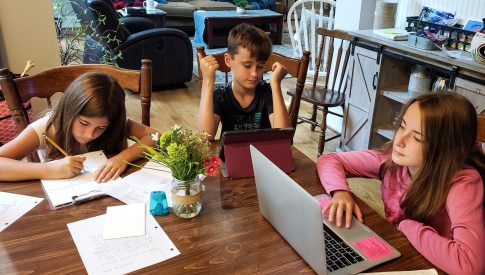Primary 4 - First Level Numeracy
Online Numeracy Lessons for Primary 4 Students in Scotland.
Primary Four numeracy and mathematics place value lessons, numbers to 10,00 teach pupils to sequence numbers to 10,000. They learn to find the number before, after and in-between. They learn to find the missing number in a sequence and the symbols for less than and more than.
They learn to find the numbers 1, 2, 10, 50, 100, 1000 more than or less than.
They learn to round a two-digit number to the nearest 10, a three-digit number to the nearest 10 and a three-digit number to the nearest 100.
We teach how to estimate the answer to a question using knowledge of rounding to the nearest 10.
We teach how to add two- and three-digit numbers without regrouping and to add two and three-digit numbers with regrouping.
Pupils learn to subtract a three-digit number without borrowing and to subtract a three-digit number with borrowing.
We teach pupils to recognise the term 'product' and to know what it means. They learn to multiply a two-digit number by 6, 7, 8 and 9. They learn to multiply a three-digit number buy 6, 7, 8 and 9.
They learn to multiply a two-digit number by 10 and a three-digit number by 10.
We teach how to divide a two-digit number by 10 without remainders and how to divide a three-digit number without remainders.
We show how to divide a two-digit number by 4, 5, 6, 7, 8 and 9. They learn to divide a three-digit number by 4, 5, 6, 7, 8 and 9.
Our fractions lessons teach how to find the basic fraction of a quantity. Pupils learn what equivalent means and can identify equivalent fractions.
Money lessons continue by teaching how to identify all the notes and count up to £20 and to find different ways of making £20 using coins and notes.
We explain how to add and subtract money up to £20 using the standard written method.
Pupils learn to use their knowledge of rounding up and counting on to calculate change from £5 and from £10.
We teach how to interpret timetables and find simple time intervals. Pupils learn to identify 'quarter past', 'half past' and 'quarter to' on display. They understand when writing the 12-hour clock you need to use a.m. and p.m.
They learn to interpret timetables and calculate simple time intervals.
Pupils learn to change between the 12 and 24-hour clock.
We teach how to use a calendar to answer questions. Pupils learn to identify the features of a calendar, use a calendar to answer specific questions and write the date in digits.
We teach how to estimate the area of a shape by counting the squares. Pupils learn what area is and how it is measured. They learn to find the area by counting squares and how to find the area of irregular shapes.
We teach how to recognise 2D shape within 3D shapes. Pupils learn to identify and name the features of a 2D shape, to identify and name the features of a 3D shape and to identify the nets of some 3D shapes.
Pupils learn to identify the four compass points and directions as well as identifying a right angle in relation to quarter, half and full turns. Pupils learn to describe direction in terms of quarter, half and full turns.
We teach how to identify shapes with more than one line of symmetry. Pupils can state the definition of symmetry and identify a shape with more than one line of symmetry,
We teach grid references and co-ordinates. Pupils learn to state the position of an object on a co-ordinate grid, to identify the horizontal axis and to identify the vertical axis.
Pupils learn andling data and Carroll Diagrams. They learn what a Carroll diagram is and what it looks like. They learn to sort and organise data into four boxes based on certain criteria.
We introduce algebra and solving simple equations. Pupils learn what the definition of algebra is and to solve simple equations involving addition, subtraction, multiplication and division.
We teach how to use the mathematical symbols equal to '=' is not equal to (???) greater than > is less than <.< /p>
We teach the use of function machines so pupils can use a function machine to change one number to another. They learn the mathematical term “inverse operation” and to use this to solve function machines.


"It's bright and colourful, easy to read, and extremely easy to use unlike most textbooks or online learning websites" Daisy, S3 PupilSign Up & Learn Today

